NCERT Solutions | Class 8 Maths Chapter 8 | Comparing Quantities

CBSE Solutions | Maths Class 8
Check the below NCERT Solutions for Class 8 Maths Chapter 8 Comparing Quantities Pdf free download. NCERT Solutions Class 8 Maths were prepared based on the latest exam pattern. We have Provided Comparing Quantities Class 8 Maths NCERT Solutions to help students understand the concept very well.
NCERT | Class 8 Maths
| Book: | National Council of Educational Research and Training (NCERT) |
|---|---|
| Board: | Central Board of Secondary Education (CBSE) |
| Class: | 8th |
| Subject: | Maths |
| Chapter: | 8 |
| Chapters Name: | Comparing Quantities |
| Medium: | English |
Comparing Quantities | Class 8 Maths | NCERT Books Solutions
You can refer to MCQ Questions for Class 8 Maths Chapter 8 Comparing Quantities to revise the concepts in the syllabus effectively and improve your chances of securing high marks in your board exams.
NCERT Solutions for Class 8 Maths Chapter 8 Comparing Quantities Exercise 8.1
Ex 8.1 Class 8 Maths Question 1.
Find the ratio of the following :(a) Speed of a cycle is 15 km per hour to the speed of scooter 30 km per hour.
(b) 5 m to 10 km
(c) 50 paise to ₹ 5
Solution:
(a) Speed of cycle which is 15 km/hr to the speed of scooter which is 30 km/hr = 15 km : 30 km = 1:2.(b) 5 m to 10 km = 5m : 10 km [∵ 1 km = 1000 m, ∴ 10 km = 10000 m]
= 5 m : 10000 m
= 1 : 2000
[Dividing the 1st and 2nd terms by their HCF = 5]
(c) 50 paise to ₹ 5 = 50 paise : ₹ 5 [₹ 1 = 100 paise, ₹ 5 = 500 paise]
= 50 paise : 500 paise
= 1 : 10
[Dividing the 1st and 2nd terms by their HCF = 50]
Ex 8.1 Class 8 Maths Question 2.
Convert the following ratios to percentages :(a) 3 : 4
(b) 2 : 3
Solution:
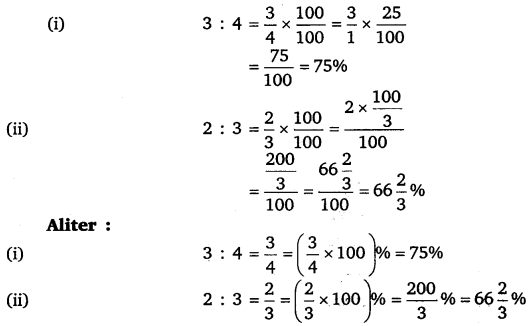
Ex 8.1 Class 8 Maths Question 3.
72% of 25 students are good in mathematics. How many are not good in mathematics?Solution:
72% of 25 students are good in mathematics.∴ (100 – 72)%, i. e., 28% of 25 students are not good in mathematics.
Thus, their number = 28% of 25
\(=\left( \frac { 28 }{ 100 } \times 25 \right) =7\) students
Ex 8.1 Class 8 Maths Question 4.
A football team won 10 matches out of the total number of matches they played. If their win percentage was 40, then how many matches did they play in all?Solution:
Let x games be played in all.Since 40% of the total games is given as 10,
∴ 40% of x = 10
⇒ \(\frac { 40 }{ 100 } \times x=10\)
⇒ \(x=\frac { 100 }{ 40 } \times 10=25\)
Ex 8.1 Class 8 Maths Question 5.
If Chameli had ₹ 600 left after spending 75% of her money, how much did she have in the beginning?Solution:
Suppose total money with Chameli at the beginning be ₹ 100.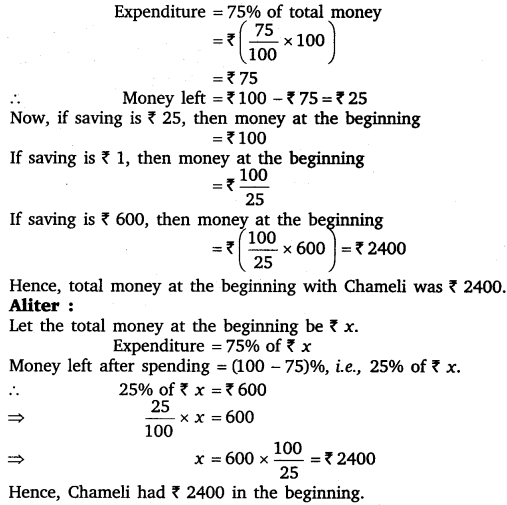
Ex 8.1 Class 8 Maths Question 6.
If 60% people in a city like cricket, 30% like football and the remaining like other games, then what per cent of the people like the other games? If the total number of people are 50 lakh, find the exact number who like each type of game.Solution:
We have,People who like cricket = 60%
People who like football = 30%
∴ People who like other games = (100 – 60 – 30)% =10%
Total number of people = 5000000
∴ People who like cricket = \(\frac { 60 }{ 100 } \times 5000000\)
= 3000000 = 30 lakh
People who like football = \(\frac { 30 }{ 100 } \times 5000000\)
= 1500000 =15 lakh
and, the people who like other games
= \(\frac { 10 }{ 100 } \times 5000000\)
= 500000 = 5 lakh.
NCERT Solutions for Class 8 Maths Chapter 8 Comparing Quantities Exercise 8.2
Ex 8.2 Class 8 Maths Question 1.
A man got a 10% increase in his salary. If his new salary is ₹ 1,54,000, find his original salary.Solution:
Let the salary before increment be ₹ 100. Then,Increase in salary = ₹ 10
∴ Increased salary = ₹ (100 +10) = ₹ 110
If increased salary is ₹ 110, original salary = ₹100
If increased salary is ₹ 154000, original salary
= ₹ \(\left( \frac { 100 }{ 110 } \times 154000 \right) \)
= ₹ 14000
Hence, the salary of the man before increment was ₹ 140000.
Ex 8.2 Class 8 Maths Question 2.
On Sunday 845 people went to the Zoo. On Monday only 169 people went. What is the per cent decrease in the people visiting the Zoo on Monday?Solution:
On Sunday the number of people went to Zoo = 845On Monday the number of people went to Zoo = 169
∴ Decrease in the people visiting the Zoo = (845-169) =676

Ex 8.2 Class 8 Maths Question 3.
A shopkeeper buys 80 articles for ₹ 2,400 and sells them for a profit of 16%. Find the selling price of one article.Solution:
CP of 80 articles = ₹ 24000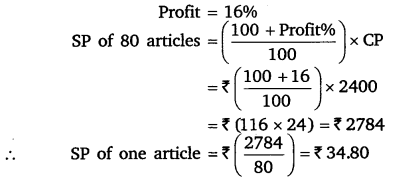
Ex 8.2 Class 8 Maths Question 4.
The cost of an article is ₹ 15,500. ₹ 450 were spent on its repairs. If it is sold for a profit of 15%, find the selling price of the article.Solution:
The effective cost price of the article is equal to the price at which it was bought plus the repair cost.∴ CP of the given article = ₹ (15500 + 450) = ₹ 15950
Profit =15%
∴ Profit =15% of ₹ 15950
= ₹ \(\left( \frac { 15 }{ 100 } \times 15950 \right) \) = ₹ 2392.50
∴ SP = CP + Profit
= ₹ (15950 + 2392.50) = ₹ 18342.50
Ex 8.2 Class 8 Maths Question 5.
A VCR and TV were bought for ? 8,000 each. The shopkeeper made a loss of 4% on the VCR and a profit of 8% on the TV. Find the gain or loss per cent on the whole transaction.Solution:
For VCR, we have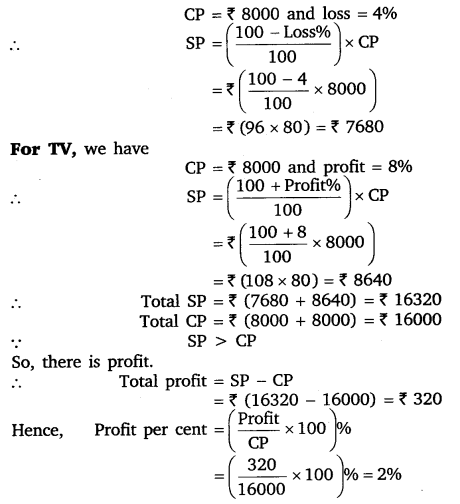
Ex 8.2 Class 8 Maths Question 6.
During a sale, a shop offered a discount of 10% on the marked prices of all the items. What would a customer have to pay for a pair of jeans marked at ? 1450 and two shirts marked at ? 850 each?Solution:
For a pair of jeans, we have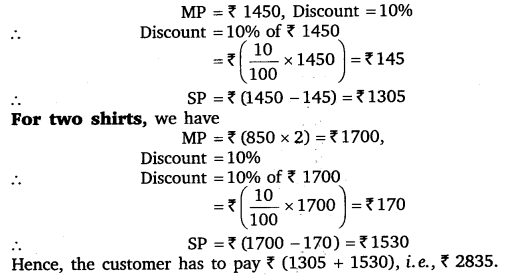
Ex 8.2 Class 8 Maths Question 7.
A milkman sold two of his buffaloes for ? 20,000 each. On one he made a gain of 5% and on the other a loss of 10%. Find his overall gain or loss.Solution:
For the first buffalo, we have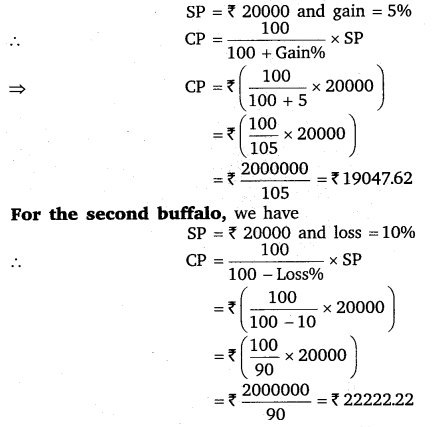
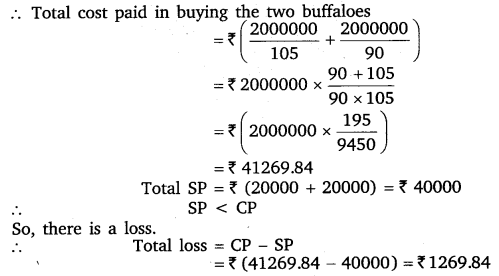
Ex 8.2 Class 8 Maths Question 8.
The price of a TV is 713,000. The sales tax charged on it is at the rate of 12%. Find the amount that Vinod will have to pay if he buys it.Solution:
List price of TV = ₹ 13000Rate of sales tax = 12%
∴ Sales tax = 12% of ₹ 13000
= ₹ \(\left( \frac { 12 }{ 100 } \times 13000 \right) \) = ₹ 1560
So, the total amount which Vinod had to pay for purchasing TV = ₹ (13000 +1560) = ₹ 14560.
Ex 8.2 Class 8 Maths Question 9.
Arun bought a pair of skates at a sale where the discount given was 20%. If the amount he pays is 11,600, find the marked price.Solution:
Let the marked price of a pair of skates be ? 100.Discount = 20% of MP
= 20% of ₹ 100 = ₹ 20
∴ SP = MP – Discount
= ₹ (100 – 20) = ₹ 80
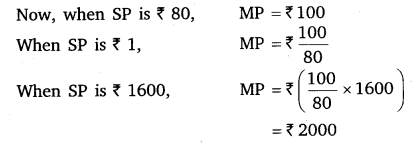
Hence, the marked price of the pair of skates is ₹ 2000.
Ex 8.2 Class 8 Maths Question 10.
I purchased a hair-dryer for ₹ 5,400 including 8% VAT. Find the price before VAT was added.Solution:
Let the price of hair-dryer before VAT be ₹ x.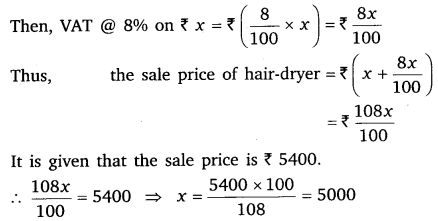
Hence, the price of hair-dryer before VAT was ₹ 5000.
NCERT Solutions for Class 8 Maths Chapter 8 Comparing Quantities Exercise 8.3
Ex 8.3 Class 8 Maths Question 1.
Calculate the amount and compound interest on(a) ₹ 10,800 for 3 years at 12 \(\frac { 1 }{ 2 } \) % per annum compounded annually.
(b) ₹ 18,000 for 2 \(\frac { 1 }{ 2 } \) years at 10% per annum compounded annually.
(c) ₹ 62,500 for 1 \(\frac { 1 }{ 2 } \) years at 8% per annum compounded half yearly.
(d) ₹ 8,000 for 1 year at 9% per annum compounded half yearly. (You could use the year by year calculation using SI formula to verify)
(e) ₹ 10,000 for 1 year at 8% per annum compounded half yearly.
Solution:
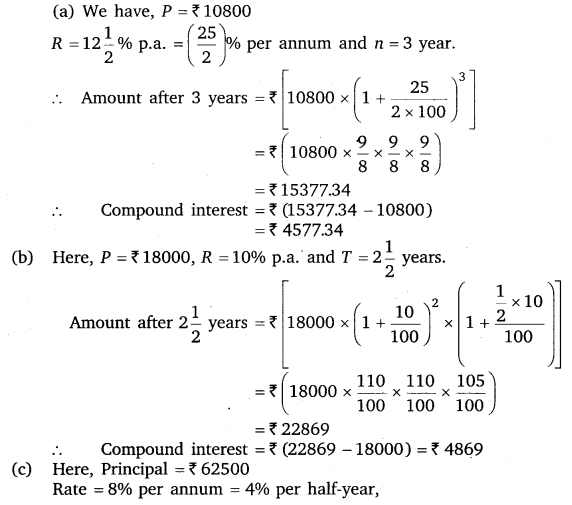
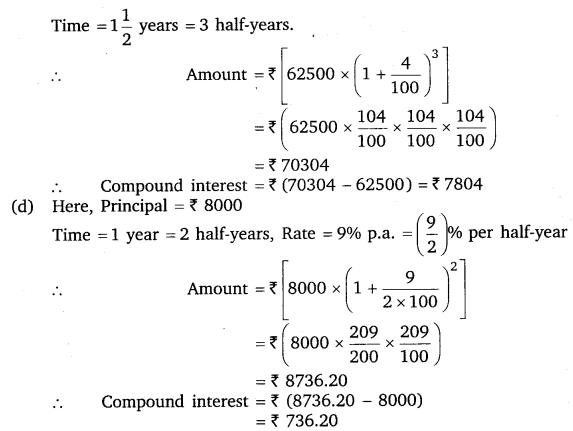
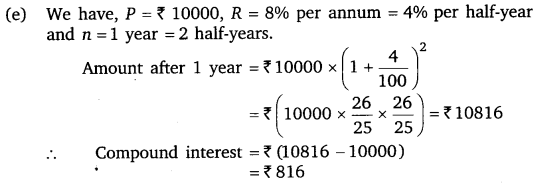
Ex 8.3 Class 8 Maths Question 2.
Kamala borrowed ₹ 26,400 from a Bank to buy a scooter at a rate of 15% p.a. compounded yearly. What amount will she pay at the end of 2 years and 4 months to clear the loan?[Hint : Find A for 2 years with interest is compounded yearly and then find SI on the 2nd year amount for \(\frac { 4 }{ 12 } \) years)
Solution:
Here, P = ₹ 26400, R =15% per annumand n = 2 years 4 months =2\(\frac { 1 }{ 3 } \) years.
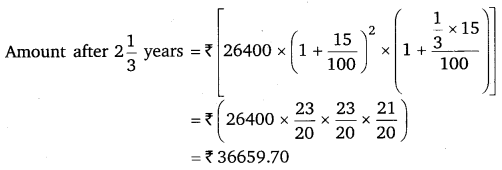
Hence, Kamala will pay ₹ 36659.70 to the bank.
Ex 8.3 Class 8 Maths Question 3.
Fabina borrows ? 12,500 at 12% per annum for 3 years at simple interest and Radha borrows the same amount for the same time period at 10% per annum, compounded annually. Who pays more interest and by how much? .Solution:
In case of Fabina :P = ₹ 12500, R =12% per annum and T =3 years. Then,
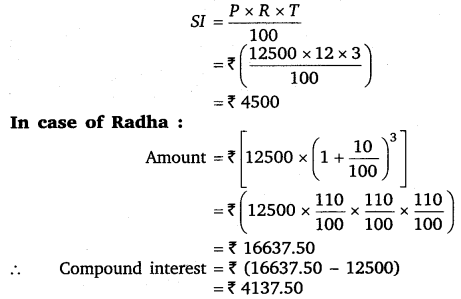
Hence, Fabina pays 362.50 more as interest ₹ (4500 – 4137.50), i.e., ₹ 362.50 more as interest.
Ex 8.3 Class 8 Maths Question 4.
I borrowed ₹ 12,000 from Jamshed at 6% per annum simple interest for 2 years. Had I borrowed this sum at 6% per annum compound interest, what extra amount would I have to pay?Solution:
Here, P = ₹ 12000, R = 6% per annum and T = 2 years.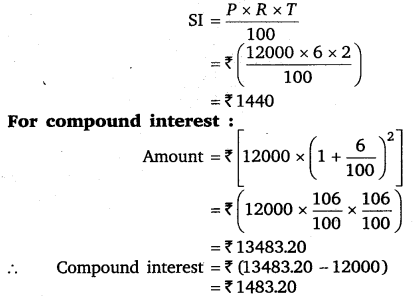
So, I have to pay ₹ (1483.20 -1440), i.e., ₹ 43.20 in excess.
Ex 8.3 Class 8 Maths Question 5.
Vasudevan invested ₹ 60,000 at an interest rate of 12% per annum compounded half-yearly. What amount would he get(i) after 6 months?
(ii) after 1 year.
Solution:
Here, Principal =₹ 60000, Rate = 12% per annum = 6%per half-year.(i) Time = 6 months = 1 half-year
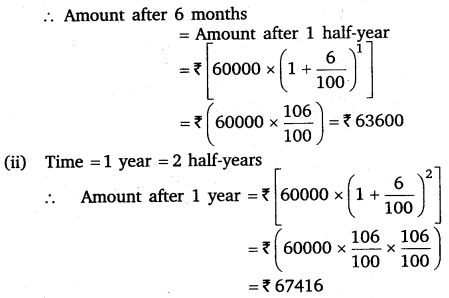
Ex 8.3 Class 8 Maths Question 6.
Arif took a loan of ? 80,000 from a bank. If the rate of interest is 10% per annum, find the difference in amounts he would be paying after 1\(\frac { 1 }{ 2 } \) years if the interest is 2(i) compounded annually
(ii) compounded half-yearly.
Solution:
Here, P = ₹ 80000Rate = 10% per annum = 5% per half-year,
Time = 1\(\frac { 1 }{ 2 } \) years = 3 half-years.
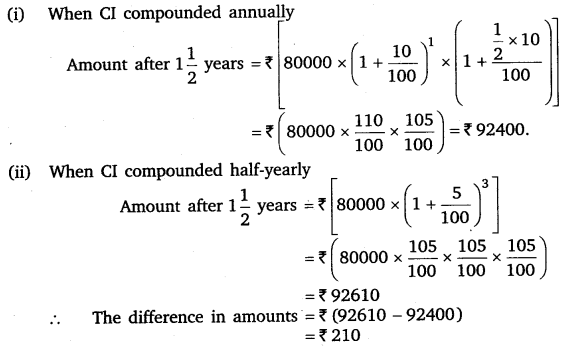
Ex 8.3 Class 8 Maths Question 7.
Maria invested ? 8,000 in a business. She would he paid interest at 5% per annum compounded annually. Find(i) The amount credited against her name at the end of the second year.
(ii) The interest for the 3rd year.
Solution:
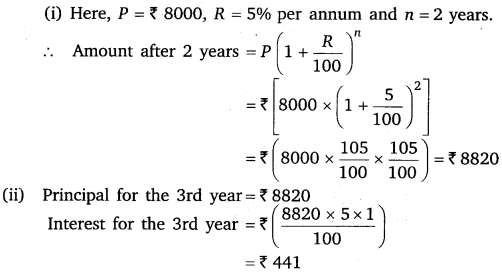
Ex 8.3 Class 8 Maths Question 8.
Find the amount and the compound interest on ? 10,000 for 1\(\frac { 1 }{ 2 } \) years at 10% per annum, compounded half-yearly. Would this interest be more than the interest he would get if it was compounded annually?Solution:
Here, Principal = ? 10000Time = 1\(\frac { 1 }{ 2 } \) years = 3 half years,
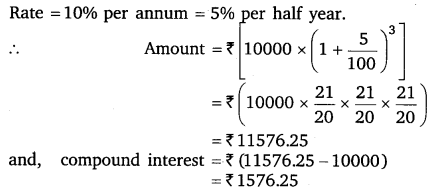
This interest is more than the interest that he would get if it was compounded annually.
Ex 8.3 Class 8 Maths Question 9.
Find the amount which Ram will get on ₹ 4096, if he gave it for 18 months at 12\(\frac { 1 }{ 2 } \) % per annum, interest being compounded half yearly.Solution:
Here, Principal = ₹ 4096,Time = 18 months = 3 half years
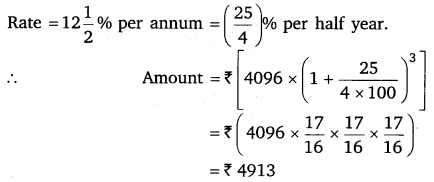
Ex 8.3 Class 8 Maths Question 10.
The population of a place increased to 54,000 in 2003 at a rate of 5% per annum(i) find the population in 2001.
(ii) what would be its population in 2005?
Solution:
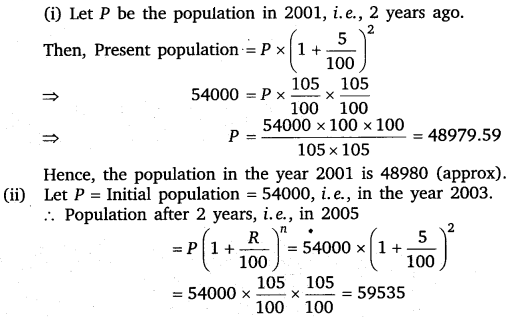
Ex 8.3 Class 8 Maths Question 11.
In a Laboratory, the count of bacteria in a certain experiment was increasing at the rate of 2.5% per hour. Find the bacteria at the end of 2 hours if the count was initially 5,06,000.Solution:
We have, P = Original count of bacteria = 506000;Rate of increase = R = 2.5% per hour, Time = 2 hours.

Ex 8.3 Class 8 Maths Question 12.
A scooter was bought at ? 42,000. Its value depreciated at the rate of 8% per annum. Find its value after one year.Solution:
We have, V0 = Initial value = ₹ 42000R = Rate of depreciation = 8% p.a.
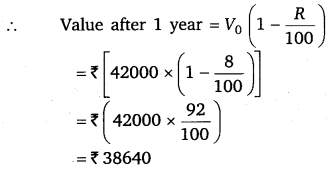
NCERT Class 8 Maths
Class 8 Maths Chapters | Maths Class 8 Chapter 8
NCERT Solutions for Class 8 Maths
NCERT Solutions of Maths Class 8 Chapter-wise
Chapter-wise NCERT Solutions for Class 8 Maths
-
NCERT Solutions For Class 8 Maths Chapter 1 Rational Numbers
NCERT Solutions For Class 8 Maths Chapter 2 Linear Equations in One Variable
NCERT Solutions For Class 8 Maths Chapter 3 Understanding Quadrilaterals
NCERT Solutions For Class 8 Maths Chapter 4 Practical Geometry
NCERT Solutions For Class 8 Maths Chapter 5 Data Handling
NCERT Solutions For Class 8 Maths Chapter 6 Squares and Square Roots
NCERT Solutions For Class 8 Maths Chapter 7 Cubes and Cube Roots
NCERT Solutions For Class 8 Maths Chapter 8 Comparing Quantities
NCERT Solutions For Class 8 Maths Chapter 9 Algebraic Expressions and Identities
NCERT Solutions For Class 8 Maths Chapter 10 Visualising Solid Shapes
NCERT Solutions For Class 8 Maths Chapter 11 Mensuration
NCERT Solutions For Class 8 Maths Chapter 12 Exponents and Powers
NCERT Solutions For Class 8 Maths Chapter 13 Direct and Indirect proportions
NCERT Solutions For Class 8 Maths Chapter 14 Factorisation
NCERT Solutions For Class 8 Maths Chapter 15 Introduction to Graphs
NCERT Solutions For Class 8 Maths Chapter 16 Playing with Numbers
NCERT Solutions for Class 6 to 12
-
NCERT Solutions for Class 6 All Subjects
NCERT Solutions for Class 7 All Subjects
NCERT Solutions for Class 8 All Subjects
NCERT Solutions for Class 9 All Subjects
NCERT Solutions for Class 10 All Subjects
NCERT Solutions for Class 11 All Subjects
NCERT Solutions for Class 12 All Subjects

Post a Comment
इस पेज / वेबसाइट की त्रुटियों / गलतियों को यहाँ दर्ज कीजिये
(Errors/mistakes on this page/website enter here)